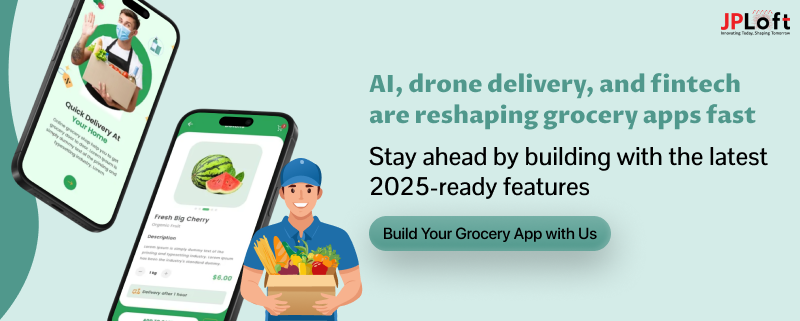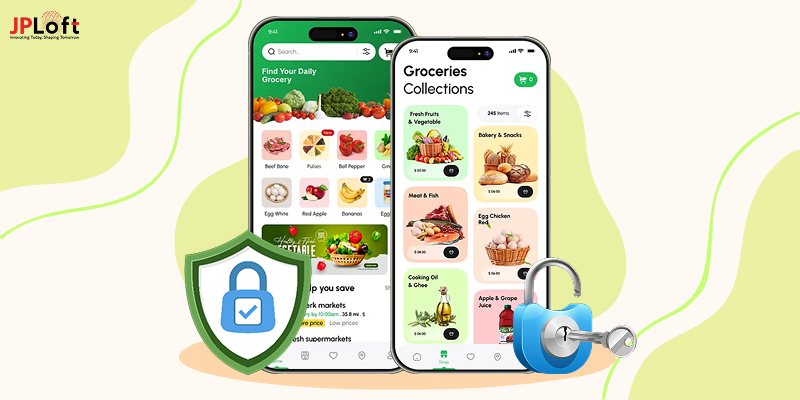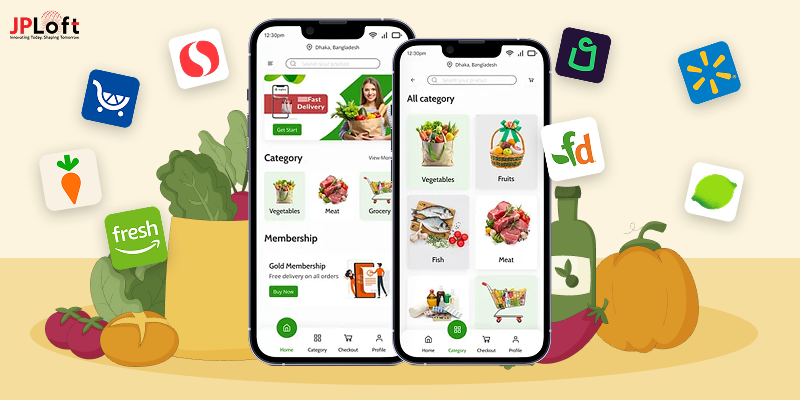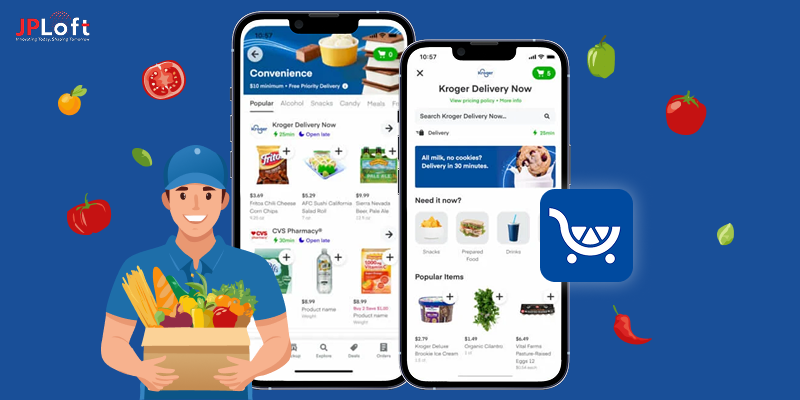In 2025, grocery delivery apps are at the forefront of digital transformation in the retail industry. They combine seamless tech, smart logistics, and AI-driven personalization to meet the rising expectations of global consumers. This year, we see exciting trends transforming how groceries are ordered, delivered, and experienced.
From AI-powered personalized recommendations and eco-friendly packaging to drone deliveries and seamless payment options, grocery delivery apps are pushing the boundaries of innovation. Additionally, sustainability and local sourcing are gaining traction, reflecting a growing consumer focus on ethical consumption.
In this blog, we’ll explore the grocery delivery app trends in 2025, highlighting how these developments are redefining convenience, efficiency, and customer satisfaction in the food retail industry. Whether you’re a consumer, retailer, or tech enthusiast, these insights will help you understand the future of grocery delivery.
Key Takeaways
Grocery delivery apps are required to follow the trendy changes and requirements, combining smart logistics, AI-powered benefits, and sustainability.
The market is experiencing rapid growth, expected to reach approximately USD 938.98 billion in 2025, with a CAGR of 9.7%.
AI, ML, and NLP technologies provide optimized delivery routes, demand forecasting, hyper-personalization, and real-time customer support.
Key trends of 2025 are AI/AR integration, hyper-fast delivery, sustainability, transparency, health-centric solutions, and social and collaborative features.
Contact JPLoft for an end-to-end development partner for your grocery delivery app, enhanced with the latest popular trends of the market.
Grocery Delivery App Concept and Stats
A grocery delivery app is a digital platform that connects consumers to grocery stores virtually, in the convenience of a mobile application. It allows users to browse products, place orders, make payments, and schedule or track deliveries, all from the comfort of their homes. These apps have transformed everyday grocery shopping into a seamless, digital-first experience.
Let’s look at the current statistics of the grocery delivery app market to understand the benefits of investing in it:
-
According to Statista, the global online grocery delivery services market is estimated to be USD 938.98 billion in 2025, with a CAGR of approximately 9.7%.
-
According to Zion Market Research, by the year 2034, the online grocery delivery market will surpass USD 5.6 trillion in revenue with a CAGR of 25.8% between 2024 and 2034.
-
Almost 150 million customers in the U.S. (nearly half the population) shop frequently from an online grocery store, according to LLCBuddy.
-
In a study by LLCBuddy, approximately 70% of US households ordered groceries online at least once a month, with an average of 2-3 orders per month per household.
Whether for startups or established grocery chains, launching or refining grocery delivery app trends, 2025 is a timely, profitable opportunity supported by powerful market momentum and strong consumer demand. Now we will go through trends to follow for grocery delivery app development that can affect your business.
Why Consider Grocery Delivery Trends?
If you are a retail owner, run a grocery item business, or operate a grocery delivery startup, staying informed about grocery delivery app trends in 2025 is crucial for both consumers and businesses in today's rapidly evolving marketplace.
Here we have listed the reasons why staying up-to-date with the grocery delivery app trends is important for you:
A] Consumer Expectations Are Rapidly Changing
Modern shoppers increasingly value convenience, speed, and personalization. By staying up-to-date and understanding the latest trends for grocery delivery apps, like ultra-fast delivery or AI-powered recommendations, you can make better choices and align with services that fit your business type.
B} Technology is Redefining the Shopping Experience
New tech, such as automation, robotics, drones, and smart home integration, is transforming how groceries are ordered, detected, and delivered. Knowing what's possible keeps you ahead of the curve and helps you take advantage of innovations, whether it's voice-activated ordering or real-time tracking.
C] Competitive Advantages for Businesses
For retailers, staying on top of the 2025 grocery delivery app trends can mean increased customer loyalty, improved efficiency, and smarter marketing. Adapting to what’s trendy, such as subscription models, omnichannel options, or group shopping features, is crucial for remaining relevant in the current market.
D] Adaptation Leads to Cost Savings and Better Experiences
Knowing where the industry is heading helps both consumers and companies adapt early, potentially saving money and enjoying smoother, more satisfying experiences, from easier bulk ordering to optimized supply chains.
E] Health and Wellness Are Driving Innovation
As more people demand health-centric products and services, emerging trends for grocery delivery apps highlight how grocery delivery platforms are evolving to offer customized meal kits, delivery filters, and fresh local choices. This trend awareness gives you the power to modulate your business accordingly and attract loyal customers.
F] Anticipating Market Growth
The grocery delivery market is growing rapidly, with new competitors and models emerging all the time. Keeping up with the trends prepares you for future changes, ensuring you don't miss out on any opportunity by shifting market norms.
Considering grocery delivery trends ensures you are ready to make smarter, more sustainable, and customer-conscious choices, helping you upgrade your online grocery delivery business.
On understanding the requirements of being updated with the latest trends, we will go through the unique trends for grocery delivery apps of 2025.
Top Grocery Delivery Trends in 2025
The online grocery delivery industry in 2025 has been entirely reshaped with innovation, technology, and ever-evolving consumer expectations.
Let's dive into the leading grocery delivery app trends guide that has transformed the way groceries are delivered nowadays:
1. Hype Convenience and Super-Fast Delivery
In the current fast-paced economy, next-day grocery delivery already feels slow compared to the year’s standard. Many leading platforms are now promising customers 10 to 30 minutes of grocery delivery at their doorsteps.
Achievable through a rise in micro-fulfillment centers, AI-optimized routes, and dark stores dedicated solely to online orders. Providing seamless, reliable experiences that fit customers' busy lives.
2. AI-Personalized and Smart Recommendations
AI, being the heart of the grocery delivery apps, becomes extraordinarily good at understanding customer preferences, analyzing shopping patterns and dietary needs, and even anticipating when they require the next stocking of groceries.
Creating an AI app with advanced recommendation systems suggests recipes, generates dynamic shopping lists, and minimizes food wastage by tracking food stock in your pantry.
3. Enhanced Payment & Fintech Integration
Apps now include flexible payment options like BNPL (Buy Now, Pay Later), digital wallets, crypto payments, and one-tap reordering. Create a grocery delivery app with secure, seamless transactions to improve checkout speed and user satisfaction.
Fintech integrations like Klarna’s buy‑now‑pay‑later grocery delivery apps provide flexibility—letting customers split checkout into interest‑free installments and boosting conversion.
4. Sustainable Delivery, Packaging, and Practices
Sustainability is now a core expectation. Customers demand eco-friendly options in every possible situation and have become one of the popular emerging trends for grocery delivery apps.
Including electric vehicles for delivery and biodegradable packaging has become a mainstream requirement. Some grocery delivery apps now provide the option of choosing a sustainable filter, allowing customers to go green.
5. Advanced Tracking, Transparency, and Augmented Reality
Real-time tracking now includes ETA down to the minute, live map views, and temperature control tracking for perishables.
This transparency increases user trust and enhances the post-order experience. With the help of AR, shoppers get the option to look at the product virtually, assess freshness, and even visualize recipes using what’s in the customers’ pantries.
6. The Rise of Quick Commerce and Micro-Fulfilment Centers
Micro-fulfillment centers, compact, automated warehouses close to the customers, are the core reasons for the success of the quick commerce sector.
Allowing them to scale rapidly and helping them ship orders in minutes. Robots and automation, both in warehouses and in delivery vehicles, are more common nowadays than ever, cutting costs and boosting speed.
7. Subscription Models, Memberships, and Loyalty
Almost every grocery opts for a subscription/membership model for its customers. These memberships come with benefits such as free delivery, priority slots, and exclusive deals for a monthly/quarterly/yearly fee.
These programs drive platform loyalty and offer helpful perks for regular customers, helping in customer retention and conversion rate.
8. Integration with Local and Private Labels
As shoppers grow more price-conscious, private-label and local brands see explosive growth. Delivery services increasingly feature store brands, which offer value and unique options, favoring the customers.
Integrations with the neighborhood stores and farms support fresh, hyperlocal products and boost small businesses, all while reducing the delivery time.
9. Autonomous and Drone Deliveries
Autonomous vehicles and delivery drones are revolutionizing last-mile logistics. Companies like Amazon Fresh and Ocado are piloting these systems to reduce cost, enhance delivery speed, and expand into hard-to-reach areas.
As regulations evolve, we’re likely to see wider deployment in urban zones and gated communities by the end of 2025.
10. Health Consciousness and Curated Curation
Shoppers in 2025 are health-conscious and prefer groceries that promote wellness, whether they are plant-based, keto, low-sodium, or organic.
Many grocery delivery apps curate health-centric product collections and even offer in-app support for filtering by dietary preferences, allergies, or nutritional criteria. Also, provide meal kit options tailored to specific diets or health goals.
11. Social and Collaborative Shopping
Nowadays, ordering groceries has become a social task. Families, roommates, or friends can now create and share shopping lists, split bills, or make group orders, all within the same app.
Community features are one of the new trends in grocery delivery apps, allowing customers to share recipes and cooking tips and facilitating group discounts for bulk ordering.
12. Seamless Omnichannel Experiences
Retailers are offering a unified shopping journey across app, web, and physical stores. Customers can order online and pick up in-store, scan and go, or opt for curbside delivery, increasing convenience and flexibility.
This seamless integration builds stronger brand loyalty and ensures shoppers stay engaged across every touchpoint.
13. Direct-to-Consumer (DTC) Sales by Brands
Manufacturers are cutting through the traditional retail process by selling products directly to their consumers through these grocery delivery apps.
It is one of the trends in grocery delivery apps that cuts middlemen, improves margins, and offers fresher products while giving consumers access to unique, local, or niche brands.
The grocery delivery app trends, 2025, is a collaboration of technology meeting urgency, with convenience, personalization, and sustainability at the heart of innovation. The blending of instant logistics, AI-driven insights, green initiatives, and e-commerce has made this industry unrecognizable.
In the next section, we will see how the integration of advanced technology like AI, ML, and NLP is benefiting the grocery delivery app trends in 2025.
Why AI, ML, and NLP are Key Grocery Delivery App Trends?
Modern-day advanced technology like AI, ML, and NPL is a significant 2025 grocery delivery app trends shaping the grocery delivery app in 2025.
With their extensive enhanced personalization, efficiency, and user experience, an experienced AI app development company can integrate AI to meet the rising consumer demands and redefine how the entire ecosystem operates.
► Hyper-Personalization and Smart Recommendations
ML analyzes vast pools of user data, including purchase history, preferences, seasonal grocery delivery app trends for 2025, and even content-specific details like weather.
This helps them deliver ultra-personalized shopping experiences for the customers. Apps offer tailored product suggestions, meal recommendations, and anticipate grocery needs before customers even search.
► Seamless, Natural User Interaction with NPL
Instead of lengthy manual typing, customers can now build shopping lists or place orders by just speaking naturally with the help of NLP integrations.
Create a mobile app for grocery ordering with voice assistants and AI-driven chatbots that answer questions, manage orders, handle complaints, and even provide recipe suggestions in real time. Making the process faster, more accessible, and more human.
► Instant Customer Support and Smart Chatbots
AI-powered chatbots operate 24/7, providing immediate solutions to queries, guiding users through upgrades or troubleshooting of apps, and keeping them updated about order status.
These virtual agents continually learn from interactions to improve their accuracy, reducing human intervention requirements and ensuring a smooth experience.
► Optimized Delivery and Logistics
ML algorithms are core for route optimization and logistics, being the future of grocery delivery apps. They assess real-time traffic, weather, order locations, and other external factors to suggest the most efficient routes.
AI dynamically reroutes drivers or even leverages autonomous vehicles and drones in some urban areas. This helps in meeting the consumer expectations of fast delivery.
► Accurate Inventory and Demand Forecasting
AI analyzes current and historical sales patterns to predict spikes in demand, enabling precise inventory management, avoiding out-of-stock issues, and reducing off-demand products from inventory.
Smart forecasting ensures popular items are fully stocked during holidays or events. AI can even adjust the pricing dynamically in response to demand or competitor pricing, maximizing affordability and revenue generation from grocery delivery apps.
► Reducing Fraud and Increasing Security
Advanced AI systems continuously monitor transactions for unusual behavior, like sudden large purchases or activity from multiple unrelated locations, to detect and prevent fraud in real-time, protecting both consumers and the company.
To prevent fraud and security circumvention, hire dedicated developers to incorporate these security features into your app.
► Enhancing Marketing and Customer Retention
AI and ML empower more intelligent targeting by segmenting users based on habits. They successfully predict what offers will resonate with marketing campaigns, making them highly effective, boosting engagement and loyalty.
AI, ML, and NLP have become the backbone of the current-day grocery delivery app trends’ rapid evolution. Their adoption is crucial for staying relevant and competitive in the highly digitalized online grocery delivery landscape of 2025.
How Top Grocery Delivery Apps Are Following Key Trends?
Top grocery delivery apps ruling the market in 2025 align their strategies with technological advancements and evolving consumer expectations.
Let's take a detailed look at how top grocery delivery apps are keeping up with the grocery delivery app trends:
► Instacart: AI-Driven Personalization and Smart Recommendations
Trend Followed: Hyper-Personalization, Predictive Analytics
Key Takeaways: AI analyzes user shopping habits, preferences, and previous purchases for personalized recommendations of items. Based on local behavior, Instacart also features real-time dynamic discounts.
► Amazon Fresh: Drone Deliveries and Smart Home Integration
Trend Followed: Drone Delivery, Voice Commerce
Key Takeaways: Piloting autonomous drones in selected cities, along with deep integration with Alexa to order groceries on voice demand. Their “Dash Smart Self” services allow you to order groceries automatically before supplies run out.
► Walmart Grocery: Dark Stores and Micro-Fulfillment Centers
Trend Followed: Micro-Fulfillment, Automation
Key Takeaways: Robotic picking systems in certain selected regions to process online grocery orders faster and offer Express 2-Hour Delivery in many U.S. metro cities.
► Kroger: Sustainability and Reusable Packaging
Trend Followed: Green Delivery Models
Key Takeaways: Introduced reusable grocery bags for deliveries. Partnered with Loop, implementing zero-waste packaging solutions and providing customers with a carbon impact score per day.
► Ocado: Autonomous Vehicles and Robotic Fulfillment
Trend Followed: Autonomous Logistics, Smart Warehousing
Key Takeaways: Operations include fully robotic warehouses, AI-based order prediction, and autonomous delivery pods in selected areas. Helps them to process deliveries faster and with minimal human intervention.
► FreshDirect: Direct-to-Consumer Model and Local Sourcing
Trend Followed: DTC Grocery Supply, Ethical Sourcing
Key Takeaways: Sources directly from farms and fisheries, minimizing middlemen and maximizing freshness. Allows users to trace back the origin of each item, helping in transparency and ethical shopping.
Grocery delivery apps in 2025 are setting themselves apart by embedding AI/ML/NLP, delivering ultra-fast and transparent service, enabling natural and convenient user interactions, and addressing sustainability.
Next, let's check out how you can make your grocery delivery app business future-proof and resistant to shifting markets with the future trends of grocery delivery apps.
Tips to Future-Proof Your Grocery Delivery App Business
Future-proofing a grocery delivery app business is crucial to staying competitive and ensuring long-term success in an ever-evolving market.
Here are some strategies and tips to consider to get ahead in the market:
1. Embrace Technology and Automation
Leverage AI for predictive analytics, demand forecasting, and personalized recommendations, helping with inventory management and enhancing user experiences by suggesting the accurate product of interest.
2. Focus on Sustainability
Offer biodegradable, recyclable, or reusable packaging options, as customers are becoming more environmentally conscious. Partner with local sustainable farms and consider carbon offset initiatives like eScooters for delivery to minimize the carbon footprint.
3. Improve User Experience (UX)
Creating a seamless app design that is clean, intuitive, and fast is critical. Focus on making online shopping easy with effective product search, quick checkout, and customizable grocery delivery app features. Use data to offer personalized promotions, discounts, product suggestions, and real-time tracking of deliveries.
4. Create a Loyalty Program
Reward long-term customers with discounts, free deliveries, or exclusive access to certain products. This will increase customer retention and repeated business. Encourage users to refer your app to new customers by offering in-app credits.
5. Integrate Partnerships and Collaborations
Forge partnerships with large chains, local markets, or direct farmers to create a more diverse offering and reduce supply chain challenges. Collaborate with offices, gyms, or organizations to offer subscription-based or bulk grocery services for their employees or members.
6. Monitor Competitors and Market Trends
Keep an eye on competitors' pricing strategies, promotions, and new features. Continuously track market trends to include in a grocery delivery app to identify emerging technologies, consumer behavior, and potential disruptions in the grocery delivery space.
By focusing on the technology, sustainability, user experience, and data-driven decision-making, you can position your grocery delivery app for long-term success. Anyways, stay flexible and willing to adapt to changing customer needs, market conditions, and new opportunities.
Partner With JPLoft and Build Your Grocery Delivery App
In the rapidly evolving world of online grocery delivery, staying ahead means leveraging the best technology and industry expertise.
JPLoft, the best grocery delivery app development company, is here to solve your technological issues. Dedicated partner for building a custom, feature-rich app that truly aligns with the grocery delivery app trends guide of 2025, supporting your business growth.
At JPLoft, we understand that current consumers expect more: lightning-fast delivery, personalized shopping experiences, seamless payment options, and unmatched convenience from the palm of their hand.
Our experienced development team specializes in creating scalable, secure, and user-centric apps tailored to your unique vision, whether you’re an ambitious startup or an established retail chain.
Ready to reshape grocery shopping for the digital age? Partner with JPLoft today and turn your grocery delivery app idea into a leading platform that stands out in a fast-moving market.
Reach out for a free consultation—let’s build the future of grocery delivery together!
Conclusion
The grocery delivery landscape is evolving rapidly in 2025, driven by shifting consumer behaviors, technological advancements, and an increasing demand for convenience, and staying updated with these is crucial for online grocery delivery app businesses.
The industry’s explosive growth, fueled by changing habits, robust investment, and bold innovation, shows no sign of slowing. By delivering smarter recommendations, automating logistics, personalizing experiences, and enabling natural interactions, modern-day technologies allow grocery apps to meet and exceed the expectations of present-day consumers while helping businesses scale, optimize, and innovate continually.
Prioritizing the experience and building customer loyalty through membership benefits and integrated support systems. The future of how we shop for and receive our food is smarter, faster, and greener than before.
FAQs
Some of the most popular grocery delivery app trends include hyper-fast and real-time delivery, AI-driven personalization, voice-enabled ordering, sustainable practices, integrations with smart home devices, enhanced loyalty programs, and ultra-secure payment options.
AI is powering everything from product recommendations and personalized promotions to precise inventory management and ultra-efficient delivery route optimization. It’s also used in smart chatbots for instant customer support and in predictive analytics for restocking and dynamic pricing.
Yes, ultra-fast delivery is now the norm among leading platforms, with many promising groceries at your door within 10-30 minutes to a couple of hours, enabled by micro-fulfillment centers, automated routing, and increased use of robotics and drones.
Top features include real-time order tracking, subscription and loyalty benefits, voice and chatbot assistance, personalized shopping lists, flexible delivery windows, and in-app diet or allergy filters.
Yes, it is estimated that the online grocery delivery sector will keep on growing after 2025. The market is expected to witness rapid expansion with a CAGR of 25.8%, with global revenue projected to reach nearly $5 trillion by the next decade.













Share this blog